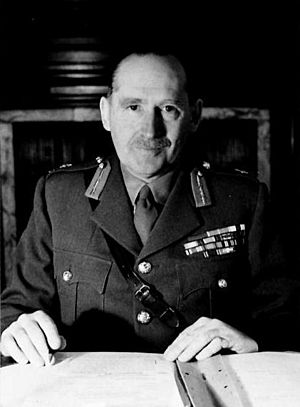Daril Watson facts for kids
Quick facts for kids
Sir Daril Watson
|
|
|---|---|

Lieutenant General Sir Daril Watson in 1946
|
|
| Born | 17 October 1888 Edmonton, London, England |
| Died | 1 July 1967 (aged 78) Hadlow Down, Uckfield, East Sussex, England |
| Allegiance | |
| Service/ |
|
| Years of service | 1914–1947 |
| Rank | General |
| Service number | 9758 |
| Unit | Royal Fusiliers Highland Light Infantry Duke of Cornwall's Light Infantry |
| Commands held | 1st Battalion, Duke of Cornwall's Light Infantry Senior Officers' School, Belgaum 2nd Infantry Division Western Command |
| Battles/wars | World War I World War II |
| Awards | Knight Grand Cross of the Order of the Bath Commander of the Order of the British Empire Military Cross |
General Sir Daril Gerard Watson (17 October 1888 − 1 July 1967) was an important British Army officer. He served during both World War I and World War II. He held many key leadership roles throughout his long career.
Contents
Sir Daril Watson's Army Career
Early Years and World War I
Daril Watson was born on October 17, 1888. He went to Mercers' School when he was younger. When World War I started in August 1914, he joined the British Army. He became a soldier in the 10th Battalion of the Royal Fusiliers.
The next year, in 1915, he became an officer. He joined the 12th Battalion of the Highland Light Infantry. In 1917, he received the Military Cross (MC). This award is given for bravery in battle. He also got married in the same year.
Between the World Wars
After World War I, Daril Watson continued his training. He attended the Staff College, Camberley from 1924 to 1925. This college teaches officers how to plan and lead.
In 1928, he moved to the Duke of Cornwall's Light Infantry (DCLI). By 1934, he became the Commanding officer (CO) of the 1st Battalion, DCLI. This meant he was in charge of that group of soldiers. In 1937, he was made the Commandant of the Senior Officers' School, Belgaum in India. This school trained older officers.
World War II Service
Sir Daril Watson played a big part in World War II. At first, he was a brigadier on the General Staff at Eastern Command. Then he moved to the General Staff of III Corps.
In 1940, he became the General Officer Commanding (GOC) of the 2nd Infantry Division in India. This meant he led a large group of soldiers. In 1941, he became the Director of Staff Duties at the War Office. This office helped manage the army.
In 1942, he was appointed Assistant Chief of the Imperial General Staff (ACIGS). He then became the Deputy Adjutant General. These were very important roles in the army's leadership. In 1944, he became the General Officer Commanding-in-Chief (GOC-in-C) for Western Command.
Later Career and Retirement
On August 17, 1946, Daril Watson was promoted to the rank of General. This is one of the highest ranks in the army. In 1946, he became the Quartermaster-General to the Forces. He was in charge of supplies and equipment for the entire army. He retired from the army in 1947.
After retiring, he joined the board of the British Transport Commission. This group helped manage transportation in Britain.

